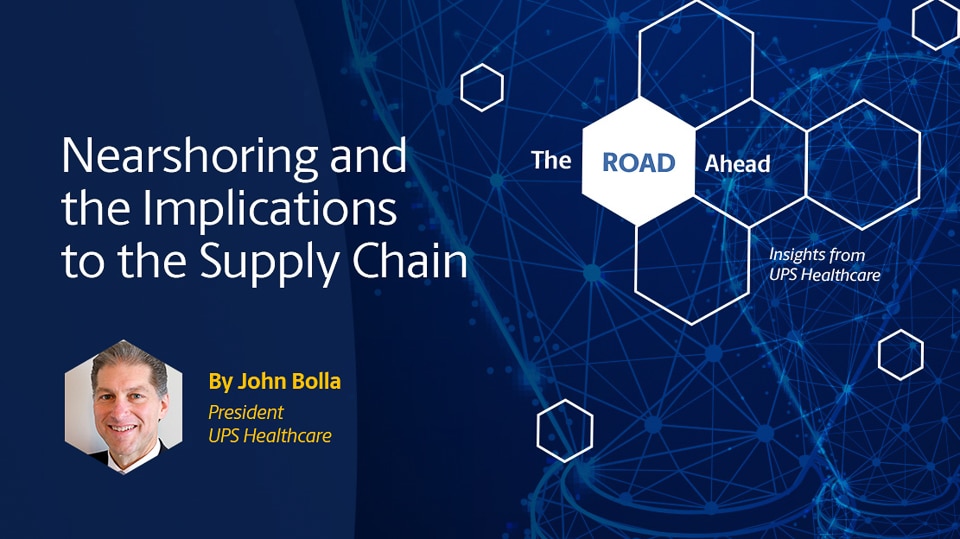While spending time at our recent 2022 UPS Healthcare Forum, I thought a lot about WHY I work in healthcare ... my personal purpose. It's the reason I love what I do. It's the patient – the person at the end of the supply chain, who trusts each of us to deliver.
For me personally, one patient vividly stands out in my memory and represents for me the mission of my work - his name was Nick. And years ago, I coached him in little league in North Carolina. Nick had chronic asthma. The little guy always had to carry an inhaler. Back then, I worked for a pharmaceutical company, and my factory manufactured and distributed the very inhaler that Nick carried. The inhaler that could save his life.
What we do in the healthcare supply chain can sometimes get lost in the daily activities of our industry. It's good to have a reminder sometimes that what we do impacts real people living real lives. Ensuring effective and efficient distribution of innovative healthcare products, and closing the final loop in the supply chain, means kids like Nick get life-saving medicines.
Our global healthcare environment is dynamic, constantly in flux. The challenges of change affect supply chains and drive costs. One particular trend in healthcare – nearshoring – has suddenly moved much closer to the center of our decision-making.
For several years, we've heard quiet talk about bringing sourcing and production of healthcare goods closer to markets, closer to customers. There were good reasons:
- Doubts about the exposure and cost of Asian production and supply chains
- Increased labor expenses
- Challenges in speed to market from a distance
- A growing emphasis on environmental, social, and governance (ESG) sustainability goals
The pandemic, of course, brought all these issues into the floodlights. Suddenly, labor didn't just cost more – labor wasn't available at all. Just when they were most needed, Asian supply chains became twisted and often broke. Also, troublesome questions about the treatment and human rights of labor work forces emerged in China. Plus, protecting intellectual property in Asia had always been an issue…and it never seemed to get better.
So, for all these reasons, the pandemic catalyzed a nascent nearshoring movement. Companies are investing to have more accessible, more manageable supply chains so they can reduce overreliance. In considering nearshoring, companies are balancing a variety of potential benefits.
Potential Benefits of Nearshoring
- Reduced exposure to intellectual property encroachment: Some companies are simply saying 'enough is enough' after dealing with ideas and information put continually at risk in countries lacking the standards of protection they'd prefer.
- Control: Manufacturers are finding that nearshoring can moderate the financial impact of restrictions on shipping and deliveries. They can invest what they save toward new commercial ventures and new products. It's why we're seeing companies take fuller control of operations ... and costs ... with nearshoring moves to Mexico, India, and Southeast Asia.
- Cost reduction: Companies can do business at lower cost by operating closer to home. Travel and logistics expenses fall off. And labor in select nearshore nations offers work of equal quality … with no hiring and training costs.
- Time zone alignment: Mexico and several South American nations share the major United States time zones. This makes collaboration easier and more efficient than with Asia. It's also an advantage to have the cultural alignment often present in shared time zones - for instance, a US company nearshoring to Latin America will likely find it easier to hire professionals who are fluent in Spanish than in Mandarin.
- Greater focus on environmental, social, and governance sustainability: Nearshoring, in a growing number of cases, is a green decision. Shorter distances for products to move. Fuel savings. Improved carbon footprint. And a lower risk of adverse events that might affect customers, compromise reputations, or damage environments.
Nearshoring is all about the health of healthcare enterprises. We can draw a straight line from the health of our companies to the health of patients. We never want to forget that our business is really the people at the end of our supply chain.
The Nicks of the world.
John Bolla is President, UPS Healthcare





